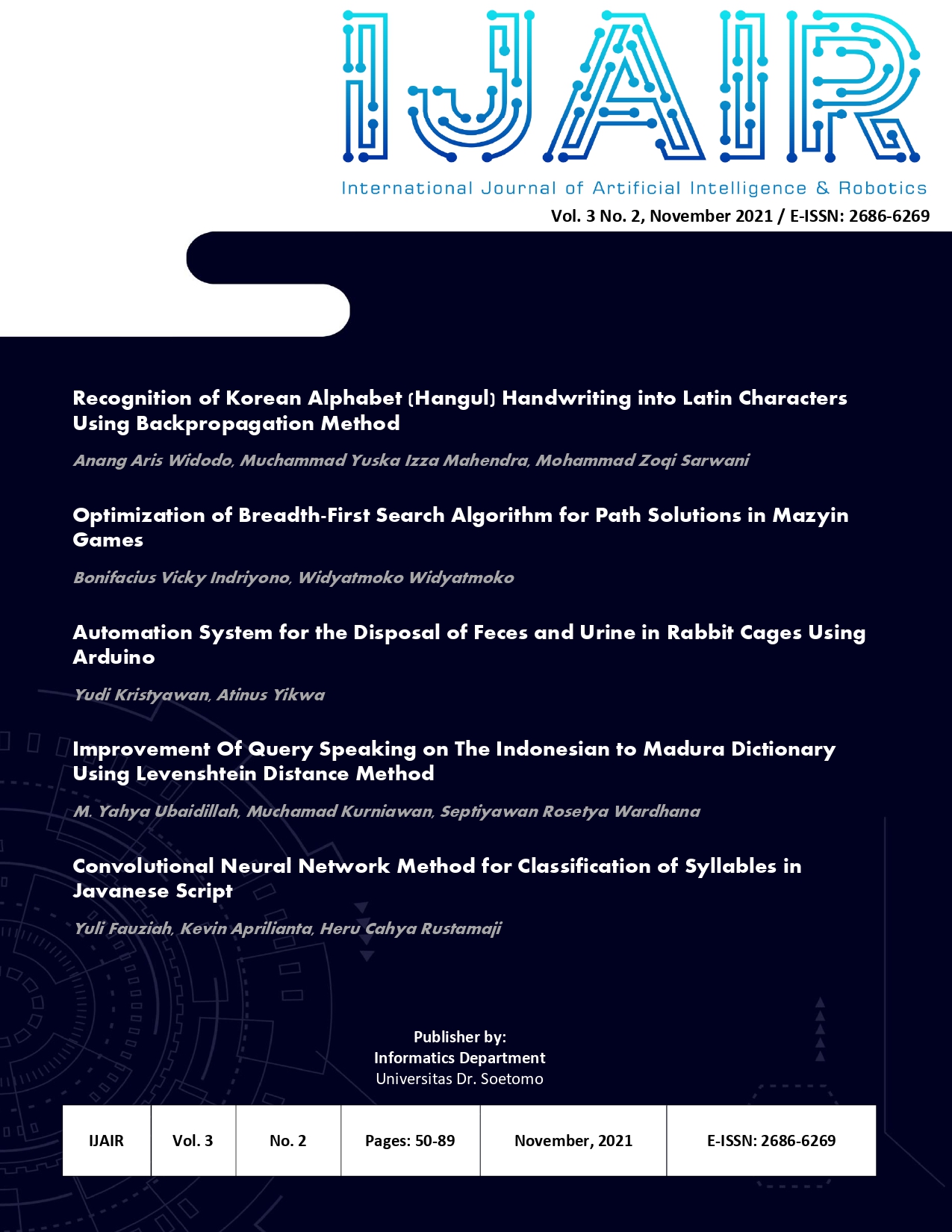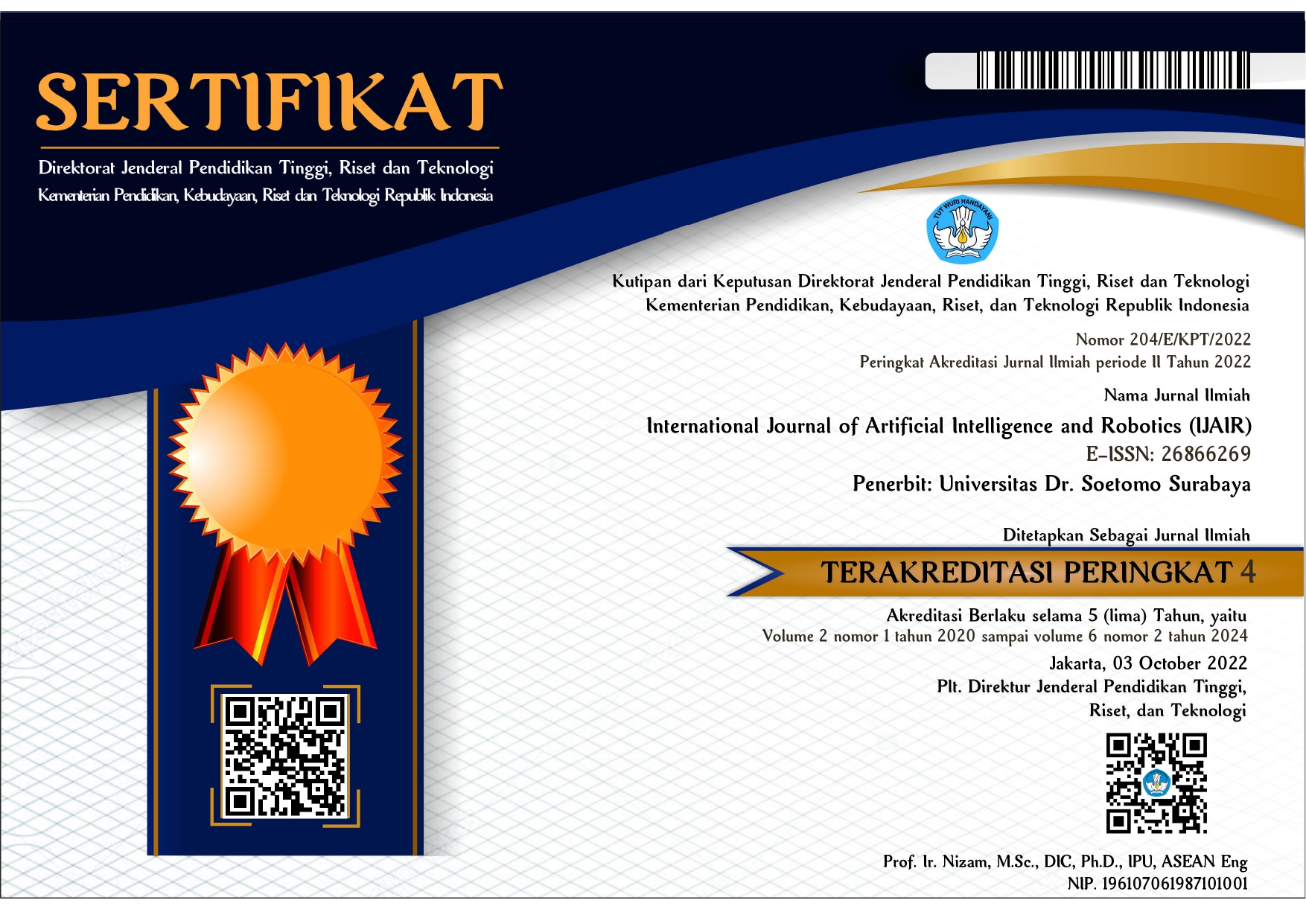Improvement Of Query Speaking on The Indonesian to Madura Dictionary Using Levenshtein Distance Method
 Abstract views: 239
,
Abstract views: 239
,
 PDF downloads: 196
PDF downloads: 196
Abstract
Men are distinguished from other living beings by their use of language, which becomes one of their most distinctive and humanistic qualities. Many different languages are spoken worldwide, including Indonesian, which has approximately 742 different dialects. Due to the unique language of Madura, which is located on a large island with numerous beach tourism destinations, tourists will have difficulty navigating the island. People outside Madura Island who come to visit or vacation will find it difficult to communicate with the locals during their stay or holiday. An Indonesian to Madurese translation dictionary is therefore required in this case. The Levenshtein Distance method was employed in this investigation. The algorithm in the dictionary is used to process the search for the closest distance (dif) between the words being inputted and the words that are already in the database. To provide a prototype for the use of dictionaries. Indonesian and Madurese data sets were used in the investigation by the researcher. According to the simulation results acquired after multiple trials, the error accuracy was 90 % for the first letter input, 84 % for the middle letter input, and 84 % for the last letter input for the first letter. As a result, according to the study's findings, the accuracy of this dictionary increased by 86 %. The first letter received 90 % of the votes, the middle letter received 84 %, and the last letter received 84 %. As a result, according to the study's findings, the accuracy of this dictionary increased by 86 %. The first letter received 90 % of the votes, the middle letter received 84 %, and the last letter received 84 %. As a result, according to the study's findings, the accuracy of this dictionary increased by 86 %.
Downloads
References
Rina Devianty (2017) ‘Bahasa Sebagai Cermin Kebudayaan’, Jurnal Tarbiyah, 24(2), pp. 226–245D. Rahmayanti and I. Pendahuluan, “Optimasi Routing Berbasis Algoritma Genetika Pada Sistem Komunikasi Bergerak,” J. Electr. Electron. Commun. Control. Informatics, Syst., vol. IV, no. 1, pp. 18–23, 2010.
Kukich, K., (1992) Techniques for Automatically Correcting Words in Text, ACM Computing Surveys, Volume 24, No.4, pp, 377-439, December.
H. T. Saidah, M. S. N. Ishlah, and N. N. Rokhmah, “Autocorrect pada Modul Pencarian Drugs e-Dictionary Menggunakan Levenshtein Distance,” Rekayasa Sist. dan Teknol. Inf., vol. 4, no. 1, pp. 64–69, 2020, [Online]. Available: https://doi.org/10.29207/resti.v4i1.1401.
Rosmala, D. and Risyad, Z. M. (2018) ‘Algoritma Levenshtein Distance dalam Aplikasi Pencarian isu di Kota Bandung pada Twitter’, MIND Journal, 2(2), pp. 1–12. doi: 10.26760/mindjournal.v2i2.1-12.
Kukich, K., (1992) Techniques for Automatically Correcting Words in Text, ACM Computing Surveys, Volume 24, No.4, pp, 377-439, December.
Umar, R., Hendriana, Y., & Budiyono, E. (2015). Implementation ofLevenshtein Distance Algorithm for E-Commerce of Bravoisitees Distro.International Journal of Computer Trends and Technology (IJCTT), 27 (3), 131-136.
Putra, M. E. W., & Suwardi, I. S. (2015). Structural off-line handwriting character recognition using approximate subgraph matching and levenshtein distance. Procedia Computer Science, 59, 340-349.
Nisa, K. and Ngafidin, M. (2015) ‘Implementasi Fitur Autocomplete dan Algoritma Levenshtein Distance untuk Meningkatkan Efektivitas Pencarian Kata di Kamus Besar Bahasa Indonesia (KBBI)’, Jurnal Teknik Elektro, 7(1), pp. 1–6. doi: 10.15294/jte.v7i1.8578.
Fauzan, R., Riadi, J. and Sholihin, F. (2018) ‘Perbandingan Metode Perhitungan Kemiripan’, Prosiding SNRT (Seminar Nasional Riset Terapan), 5662(November), pp. 1–6.
Fauzan, R., Riadi, J. and Sholihin, F. (2018) ‘Perbandingan Metode Perhitungan Kemiripan’, Prosiding SNRT (Seminar Nasional Riset Terapan), 5662(November), pp. 1–6.
Ariyani, N. H., Sutardi and Ramadhan, R. (2016) ‘Aplikasi Pendeteksi Kemiripan Isi Teks Dokumen Menggunakan Metode Levenshtein Distance’, semanTIK, Vol 2(1), pp. 279–286. Available at: http://ojs.uho.ac.id/index.php/semantik/article/download/1030/661.
Copyright (c) 2022 M. Yahya Ubaidillah, Muchamad Kurniawan, Septiyawan Rosetya Wardhana

This work is licensed under a Creative Commons Attribution-ShareAlike 4.0 International License.
Authors who publish with International Journal of Artificial Intelligence & Robotics (IJAIR) agree to the following terms:
-
Authors retain copyright and grant the journal right of first publication with the work simultaneously licensed under a Creative Commons Attribution License (CC BY-SA 4.0) that allows others to share the work with an acknowledgment of the work's authorship and initial publication in this journal.
-
Authors are able to enter into separate, additional contractual arrangements for the non-exclusive distribution of the journal's published version of the work (e.g., post it to an institutional repository or publish it in a book), with an acknowledgment of its initial publication in this journal.
-
Authors are permitted and encouraged to post their work online (e.g., in institutional repositories or on their website) prior to and during the submission process, as it can lead to productive exchanges, as well as earlier and greater citation of published work.















